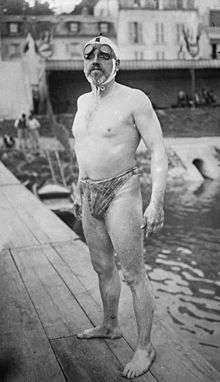Bill Burgess
 Thomas William Burgess in 1911 | |
| Personal information | |
|---|---|
| Born |
15 June 1872 Rotherham, England |
| Died |
2 July 1950 (aged 78) Paris, France |
| Height | 1.85 m (6 ft 1 in) |
| Weight | 95 kg (209 lb) |
| Sport | |
| Sport | Swimming |
| Club | Libellule de Paris |
Medal record
| |
Thomas William Burgess (15 June 1872 – 2 July 1950) was the second person to successfully complete a swim of the English Channel after Matthew Webb. He performed the feat on 6 September 1911, on his 16th attempt.[1] British by nationality, Burgess spent most of his life in France, and won a bronze medal with the French water polo team at the 1900 Olympics.[2]
Biography
Burgess was born at 7 Lyndhurst Place, Rotherham, to Alfred Burgess, a blacksmith from Youlgreave, Derbyshire, and Camilla Anna Peat, a cook from Harthill, South Yorkshire.[2] He had a younger sister, Winifred Edith Burgess, who was born in Rotherham on 11 May 1875.[3] Their father worked for the Earl of Shrewsbury and accepted the Earl's offer to run a branch of the business in London. The family moved to Westminster, London, around 1882.[2] During this time, Burgess joined a swimming club and swam to Battersea along the Thames. Around 1889 the Earl offered him the opportunity to set up a French branch of the motor tyre business in Paris. Burgess accepted and moved to France, where he spent the rest of his life.[2]
On 8 August 1893 Burgess married Anne Rosalie Mioux, a French woman, in Neuilly-Sur-Seine in Paris, and lived with her, running a motor business in Levallois-Perret. They had two children, a son born in 1896 and a daughter born in Paris in 1907. It is believed that the son fought for the British in World War I with the York and Lancaster Regiment. Burgess' maternal uncle was a head teacher at a school in Swinton, South Yorkshire. Burgess' sister married in London and had one daughter, Phyllis Camilla Ruegg, in 1898. Burgess' niece, Phyllis Camilla Ruegg, grew up to be the head of an Educational college in London and died at the age of 98 in Camden 1996.
Burgess competed in swimming and water polo at the 1900 Olympics held in Paris and won a bronze medal playing for the French team despite his British nationality, which was allowed by the rules at that time. In swimming, he finished fourth in the 4000m freestyle and fifth in the 200m backstroke events.[2]
On 6 September 1911, on his 16th attempt, Burgess became the second person to swim across the English Channel,[1][2] and the first one to use goggles. His motorcycle goggles leaked water, but they protected his eyes from water splashes during his breaststroke-only swim.[4] In the 1920s Burgess was hired by the Olympian gold medalist and world record holder Gertrude Ederle, who in 1926 became the first woman to cross the English Channel.[5] Around the same time Burgess bought a summer home at Cap Gris Nez near Calais, as a summer base to train channel swimmers from 1922 to 1934, while his main residence was at Clichy, Paris.
In 1941 Burgess was taken prisoner by the Nazis and held in a prison camp Frontstalag 142 in Besançon, France. He was released later the same year.[6]
References
- 1 2 Staff. "The Channel Swim: Burgess's Perseverance Rewarded After Fifteen failures", Poverty Bay Herald, Volume XXXVIII, Issue 12581, 11 October 1911, Page 8. Accessed 5 August 2010.
- 1 2 3 4 5 6 Bill Burgess. sports-reference.com
- ↑ "Thomas William Burgess". rotherhamweb.co.uk. Retrieved 11 August 2009.
Born on 15th June, 1872 at Lyndhurst Place, Rotherham, Thomas William Burgess was the son of Alfred Burgess, Journeyman and Blacksmith, born 1851, at Youlgreave, Derbyshire, and Camilla Ann Peat, born 1847 in Harthill. Thomas had a sister, Winifred Edith Burgess (b. 1875).
- ↑ The history of goggles. International Swimming Hall of Fame
- ↑ Gallico, Paul (19 January 1964). "First Queen of Channel Swimmers". Los Angeles Times. Retrieved 12 August 2009.
The coach who joined the party abroad was none other than that Thomas Burgess who, 15 years before, had been the second to make the Channel crossing
- ↑ "Burgess Family". Retrieved 11 August 2009.